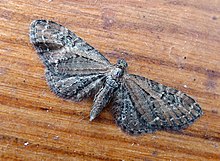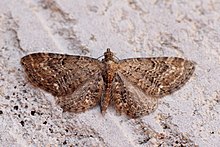Common pug
| Common pug | |
|---|---|

| |

| |
| Scientific classification | |
| Domain: | Eukaryota |
| Kingdom: | Animalia |
| Phylum: | Arthropoda |
| Class: | Insecta |
| Order: | Lepidoptera |
| Family: | Geometridae |
| Genus: | Eupithecia |
| Species: | E. vulgata |
| Binomial name | |
| Eupithecia vulgata | |
| Synonyms | |
| |
The common pug (Eupithecia vulgata) is a moth of the family Geometridae. It is a common species across the Palearctic region, including the Near East and North Africa. It ranges from the Atlantic coast of Ireland and Portugal across Europe, the Middle East and Central Asia to the Russian Far East (Priamurje) and Korea.[2]
Description
The wingspan is 18–21 mm. The ground colour of the forewings variously is very variable – brown to fuscous, with a reddish tinge, ochreous, or whitish. The darker fuscous striae are angulated and the postmedian line is biangulate. The posterior edge of the median band is marked with black, the subterminal line is interrupted into whitish dots and a small white tornal mark. The forewings have either a minute dark discal mark or are without a discal mark. Forewings with a crescentic pale tornal stain. The hindwings are similarly to the forewings but less conspicuously patterned.[3] See also Prout.[4] The larva is naked, long and slender, greyish green or light brown, on its back with a variety of rhomboid, darker spots. The reddish brown pupa has olive green wing sheaths. At the pointed cremaster there are eight hook bristles.[citation needed]

Two broods are produced each year with adults on the wing in May and June and again in August. The species flies at night and is attracted to light. It colonizes a variety of different habitats, such as forest edges, bushes, hedges, embankments and plant corridors as well as gardens and parks. The occurrence in the Alps reaches up to 1500 meters. [citation needed]
The larvae feed on a variety of plants (see list below). The species overwinters as a pupa.
Larval food plants
- Achillea – yarrow
- Artemisia
- Campanula – harebell
- Centaurea
- Crataegus – hawthorn
- Galium – bedstraw
- Salix – willow
- Senecio – ragwort
- Solidago – goldenrod
- Vaccinium – bilberry
Subspecies
- Eupithecia vulgata vulgata
- Eupithecia vulgata clarensis Huggins, 1962 Ireland
- Eupithecia vulgata lepsaria Staudinger, 1882 Kazakhstan
- Eupithecia vulgata scotica Cockayne, 1951 Scotland
References
- ^ Yu, Dicky Sick Ki. "Eupithecia vulgata (Haworth 1809)". Home of Ichneumonoidea. Taxapad. Archived from the original on 24 March 2016.
- ^ Mironov, V.G. & Ratzel, U., 2012: Eupithecia Curtis, 1825 of Afghanistan (Geometridae: Larentiinae). Nota Lepidopterologica 35 (2): 197-231. Full article: "Archived copy" (PDF). Archived from the original (PDF) on 11 August 2014. Retrieved 11 August 2014.
{{cite web}}: CS1 maint: archived copy as title (link). - ^ Eupithecia vulgata full description Watson, L., and Dallwitz, M.J. 2003 onwards. British insects: the genera of Lepidoptera-Geometridae. Version: 29 December 2011
- ^ Prout, L. B. (1912–16). Geometridae. In A. Seitz (ed.) The Macrolepidoptera of the World. The Palaearctic Geometridae, 4. 479 pp. Alfred Kernen, Stuttgart.pdf
 This article incorporates text from this source, which is in the public domain.
This article incorporates text from this source, which is in the public domain.
- Chinery, Michael Collins Guide to the Insects of Britain and Western Europe 1986 (Reprinted 1991)
- Skinner, Bernard Colour Identification Guide to Moths of the British Isles 1984
